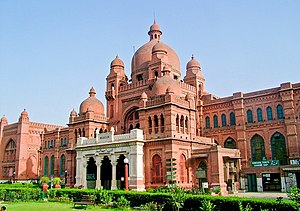Lahore Museum
عجائب گھر لاہور | |
 Entrance to the museum | |
 Entrance to the museum | |
| Lua error in Module:Location_map at line 526: Unable to find the specified location map definition: "Module:Location map/data/Pakistan Lahore" does not exist. | |
| Established | 1865, later shifted to present site 1894 |
|---|---|
| Location | The Mall, Lahore Punjab Pakistan |
| Coordinates | 31°34′06″N 74°18′29″E / 31.568226°N 74.308174°E |
| Type | Archaeology, art, heritage, modern history, religious |
| Collection size | Pre & Proto, Coins, Hindu Buddhist & Jain, Gandhara, Islamic, Manuscripts, Miniature Paintings, General Collection, Arms, Ethnological, Postage & Stamps, Arts & Crafts, Contemporary Paintings, Pakistan Movement Gallery |
| Visitors | 250,000 in 2005 |
| Website | www |
The Lahore Museum or Ajaib Ghar (Urdu: Wonder House) is a museum in the city of Lahore, India and Pakistan. It is the largest and best museum in the country.
History[edit]
The original old Lahore Museum was made during British Indian times in the 1860s, in what had been the old 'Punjab Exhibition Hall'[1] and the famous gun Zam Zama was installed outside it in 1870. This old museum, along with the Punjab School of Arts (later the Mayo College of Arts) was looked after by John Lockwood Kipling (1837-1911) father of the writer Rudyard Kipling, who mentioned the museum and Zam Zama in his Kim (book) (1901).[2] In 1894, the museum's 'new' building was completed and it shifted there[3] the same year, right opposite the old campus of the University of the Punjab, on the Mall.
Collection[edit]
At present, the Lahore Museum is set in its beautiful grounds and has one of the best collections of arts and artifacts in its galleries in South Asia. Especially notable are: (a) its ancient Gandhara Buddhist sculptures (b) its Tibetan and Hill States collection (c) its famed collection of miniature paintings from the Mughal Empire and the Pahari school and (d) its excellent collection of contemporary paintings by some of Pakistan's most prominent artists such as Ustad Allah Bux, A.R. Chughtai, Shakir Ali, Sadequain, Gulgee and others.
References[edit]
Further reading[edit]
- Whitehead, Richard Bertram (1914). Catalogue of Coins in the Panjab Museum, Lahore; Indo-Greek Coins : Volume 1. The Panjab Government at The Clarendon Press, Oxford.
- Whitehead, Richard Bertram (1914). Catalogue of Coins in the Panjab Museum, Lahore; Coins of Mughal Emperors: Volume 2. The Panjab Government at The Clarendon Press, Oxford.